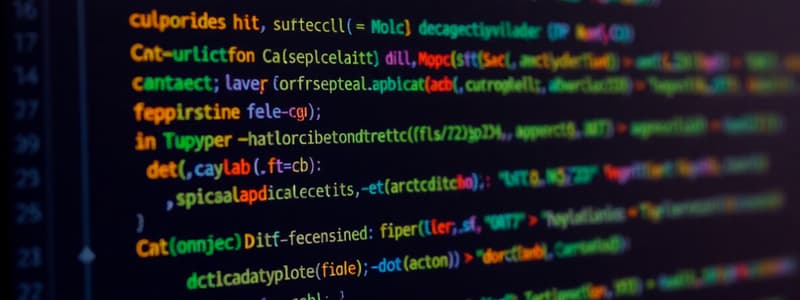Podcast
Questions and Answers
What does an object represent in object-oriented programming?
What does an object represent in object-oriented programming?
- A collection of classes
- A real-world entity with properties and behavior (correct)
- A set of functions only
- A type of access modifier
What is a class in object-oriented programming?
What is a class in object-oriented programming?
- A collection of functions only
- A blueprint or template for creating objects (correct)
- An instance of an object
- A data hiding mechanism
Which of the following correctly describes access specifiers?
Which of the following correctly describes access specifiers?
- They are used only in data functions.
- They serve as attributes of an object.
- They define the class name.
- They control how members of a class can be accessed. (correct)
Which keyword is used to define a class in C++?
Which keyword is used to define a class in C++?
What analogy is used to explain the relationship between a class and an object?
What analogy is used to explain the relationship between a class and an object?
Which of the following is NOT an access specifier in C++?
Which of the following is NOT an access specifier in C++?
When an object is created from a class, what does it inherit?
When an object is created from a class, what does it inherit?
What are members of a class comprised of?
What are members of a class comprised of?
Flashcards are hidden until you start studying
Study Notes
Objects
- An object is a real-world entity characterized by Reference/Identity, Behavior, & Property.
- Objects serve as the fundamental unit in object-oriented programming, encapsulating both data and functions.
- An object is an instance of a class, similar to how a cake is an instance of a recipe.
- Each object created from a class inherits attributes and behaviors defined in the class.
Classes
- A class is a collection or template of objects, acting as a blueprint that defines properties and behaviors.
- Classes establish the structure, behavior, and attributes that an object will have.
- To create a class, the
classkeyword is used, following a specific syntax.
Class Syntax
- The basic syntax for defining a class is:
class class_name { // Access specifier; // Data member; // Member function / Methods; };
Access Specifiers
- Access specifiers control the visibility and accessibility of class members, enforcing data hiding.
- There are three primary types of access specifiers in C++:
- Public: Members are accessible from anywhere in the program.
- Private: Members are only accessible within the class itself.
- Protected: Members are accessible within the class and its subclasses.
Access Specifier Syntax
- The syntax for defining access specifiers in a class:
class ClassName { private: // Declare private members/methods here. public: // Declare public members/methods here. protected: // Declare protected members/methods here. };
Example Class
- An example of a simple class in C++:
class MyClass { public: int publicVar; // Accessible from anywhere private: int privateVar; // Accessible only from within the class protected: int protectedVar; // Accessible from class and its subclasses public: // Constructor definition MyClass() { publicVar = 1; privateVar = 2; protectedVar = 3; } // Method to display values void displayValues() { cout << "Public: " << publicVar << " Private: " << privateVar << " Protected: " << protectedVar; } }; - The constructor initializes the properties of the object when an instance is created.
Studying That Suits You
Use AI to generate personalized quizzes and flashcards to suit your learning preferences.




